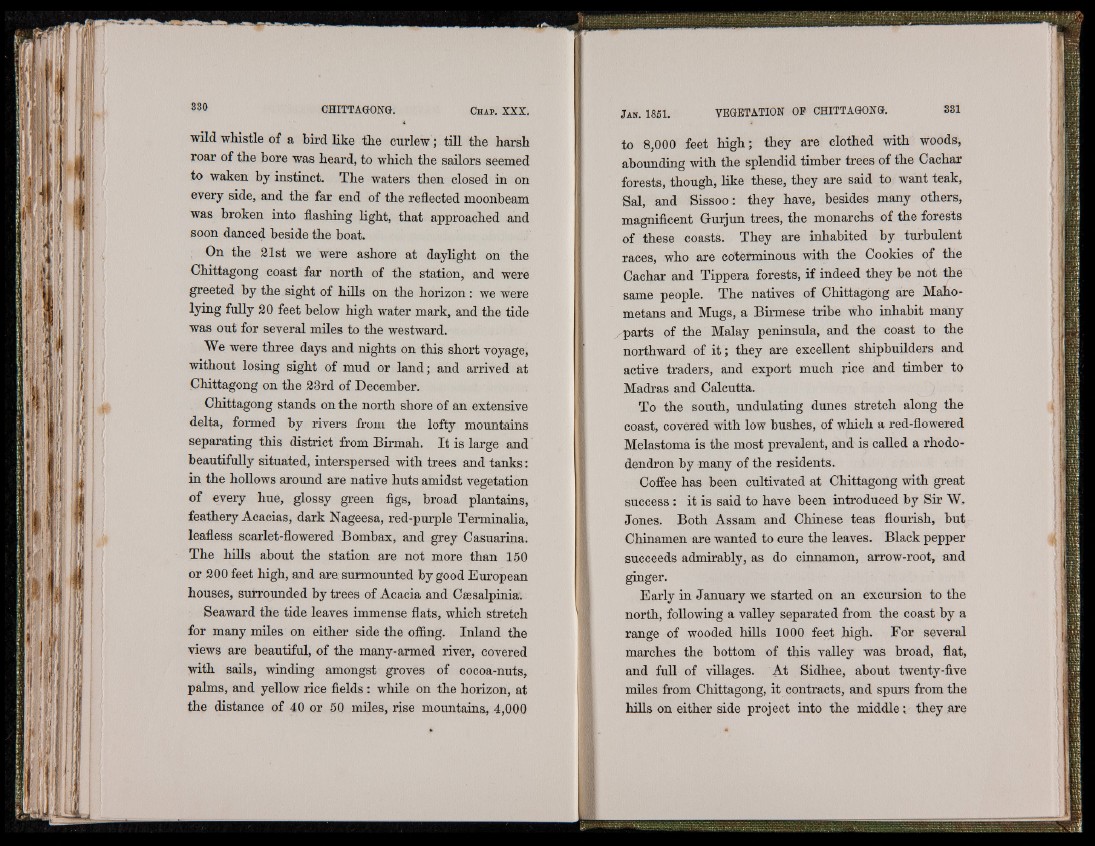
330 CHITTAGONG. Ch a p . X X X .
4
wild whistle of a bird like the curlew; till the harsh
roar of the bore was heard, to which the sailors seemed
to waken by instinct. The waters then closed in on
every side, and the far end of the reflected moonbeam
was broken into flashing light, that approached and
soon danced beside the boat.
On the 21st we were ashore at daylight on the
Chittagong coast far north of the station, and were
greeted by the sight of hills on the horizon: we were
lying fully 20 feet below high water mark, and the tide
was out for several miles to the westward.
We were three days and nights on this short voyage,
without losing sight of mud or land; and arrived at
Chittagong on the 23rd of December.
Chittagong stands on the north shore of an extensive
delta, formed by rivers from the lofty mountains
separating this district from Birmah. I t is large and
beautifully situated, interspersed with trees and tanks:
in the hollows around are native huts amidst vegetation
of every hue, glossy green figs, broad plantains,
feathery Acacias, dark Nageesa, red-purple Terminalia,
leafless scarlet-flowered Bombax, and grey Casuarina.
The hills about the station are not more than 150
or 200 feet high, and are. surmounted by good European
houses, surrounded by trees of Acacia and Csesalpinia.
Seaward the tide leaves immense flats, which stretch
for many miles on either side the offing. Inland the
views are beautiful, of the many-armed river, covered
with sails, winding amongst groves of cocoa-nuts,
palms, and yellow rice fields: while on the horizon, at
the distance of 40 or 50 miles, rise mountains, 4,000
to 8,000 feet high; they are clothed with woods,
abounding with the splendid timber trees of the Cachar
forests, though, like these, they are said to want teak,
Sal, and Sissoo: they have, besides many others,
magnificent Gurjun trees, the monarchs of the forests
of these coasts. They are inhabited by turbulent
races, who are coterminous with the Cookies of the
Cachar and Tippera forests, if indeed they be not the
same people. The natives of Chittagong are Maho -
metans and Mugs, a Birmese tribe who inhabit many
-parts of the Malay peninsula, and the coast to the
northward of i t ; they are excellent shipbuilders and
active traders, and export much rice and timber to
Madras and Calcutta.
To the south, undulating dunes stretch along the
coast, covered with low bushes, of which a red-flowered
Melastoma is the most prevalent, and is called a rhododendron
by many of the residents.
Coffee has been cultivated at Chittagong with great
success : it is said to have been introduced by Sir W.
Jones. Both Assam and Chinese teas flourish, but
Chinamen are wanted to cure the leaves. Black pepper
succeeds admirably, as do cinnamon, arrow-root, and
ginger.
Early in January we started on an excursion to the
north, following a valley separated from the coast by a
range of wooded hills 1000 feet high. For several
marches the bottom of this valley was broad, flat,
and full of villages. At Sidhee, about twenty-five
miles from Chittagong, it contracts, and spurs from the
lulls on either side project into the middle; they are